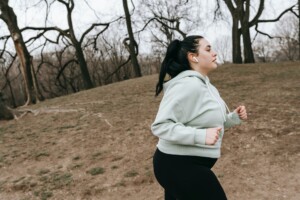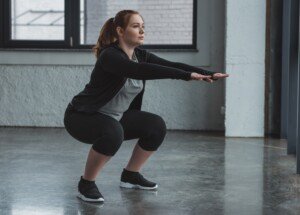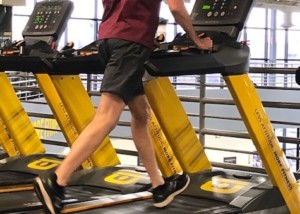
Overweight women without knee pain can enjoy trail running with these following guidelines.
If you’re plus size, and the trails are beckoning for your presence, do not let your weight withhold you from getting out there for some movement.
If you don’t have knee pain or other issues such as hip pain when jogging, you can become an effective trail runner – especially if jogging around the neighborhood has become boring, or using a treadmill is dreadfully monotonous.
“The best exercise is one that you will perform,” says Dr. Megan McLain, PT, DPT, cofounder of Intuitive Choice Physical Therapy & Wellness in Atlanta, GA.
“If trail running is something you enjoy and it’s not causing pain in your body, go for it.
“Setting yourself up for success with the proper plan and tools will help you in the long term.”
Doctor Screening

Shutterstock, S_L
“Get screening from your doctor before you start any new exercise programming,” says Dr. McLain.
“This is to ensure that there’s no potential health risks that could be proactively diagnosed.”
Even if you “feel fine” or your home blood pressure test result is normal, you should still get a complete health check, especially if you’re older.
Proper Footwear

“Make sure that you have proper footwear that provides good ankle stability and support for your arches so that you are less likely to injure yourself on the uneven terrain,” says Dr. McLain.
In fact, at the beginning you’ll want to stick to a route that’s near your car just in case you develop a blister or corn while on the trail.
Core and Lower Body Strengthening

Shutterstock/LightField Studios
“Make sure that you are involved in a progressive strengthening program for your core and lower body prior to starting — so that your muscles are able to stabilize you on the trail and various surfaces like roots, dirt and rock,” says Dr. McLain.
For example, walking lunges with just your body weight will strengthen the lower body and core at the same time.
You can also do sideways stepping combined with a slight squat.
Furthermore, bodyweight squats in one place will increase core and lower body strength.
If you go to a gym, you should use the leg press, leg extension and hamstring curl machines.
Forget sit-ups and crunches when it comes to core strength. A more effective approach is whole body movements (such as lunges and squats) for engaging the core.
When you’re jogging on a trail, you won’t be lying down or seated.
Thus, it makes no sense to rely on crunch machines, floor crunches and sit-ups to improve core strength.
New to Any Jogging

Depositphotos.com
“Start slow with walking if you haven’t been running for a while or are just getting into the sport,” says Dr. McLain.
“It’s also best to start on an even surface like a flatter trail or pavement before you run on a trail with a lot of elevation changes.
“Start with interval training [alternating jogging with recovery walking] so that you don’t overtrain yourself and increase your risk for injuries before you jog or run for the whole workout.
“This allows for your endurance to build up gradually and keeps you safe.”
If at any point you decide to use a treadmill, DO NOT HOLD ON other than for a momentary re-steadying, changing the setting or drinking from your water bottle.
If you think that holding onto a treadmill while jogging at an incline is going to prepare your body for trail running – regardless of your weight – you may as well believe that unicorns will greet you at the end of the trail with a participation trophy.
When trail running, there’s nothing to hold onto for support. So if you use a treadmill, the logical approach is to keep your hands off the equipment.
If you find it too difficult to keep your hands off, then lower the incline and/or reduce the speed – even if this means 2 mph.
Stride Length
Shorten your stride length, advises Dr. McLain.
“This decreases stress through your legs and improves your stability to limit your risk for falls, sprains and strains.”
Final Thoughts
Do not get discouraged if you’re passed up by a thinner woman flying by you on the trail.
You do not know her backstory. Perhaps she’s been trail running for a very long time.
Sustained trail running isn’t something you can accomplish overnight.
We live and work on flat land, so sustained trotting up an incline is not something your body, whether it’s plus size or not, is in the least way used to, even if you’re “up and down all day” on your home’s staircase.
In fact, doing staircase workouts won’t do much for building trail running endurance for the simple reason that the typical staircase workout is less than five minutes.
Furthermore, the biomechanics of trotting up steps differ from those of jogging a natural uphill path.
However, staircase workouts will strengthen your ankles, knees and hips, which will then be more stable on the trail.
 Dr. Megan McLain, PT, DPT, puts her clients first while providing one-on-one in-home care. With physical therapy and health coaching services, Dr. McLain addresses all aspects such as physical barriers, mindset, accountability and knowledge that may be impacting the client’s experience.
Dr. Megan McLain, PT, DPT, puts her clients first while providing one-on-one in-home care. With physical therapy and health coaching services, Dr. McLain addresses all aspects such as physical barriers, mindset, accountability and knowledge that may be impacting the client’s experience.
 Lorra Garrick is a former personal trainer certified by the American Council on Exercise. At Bally Total Fitness she trained clients of all ages for fat loss, muscle building, fitness and improved health.
Lorra Garrick is a former personal trainer certified by the American Council on Exercise. At Bally Total Fitness she trained clients of all ages for fat loss, muscle building, fitness and improved health.
.









































